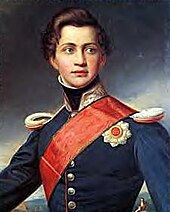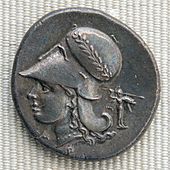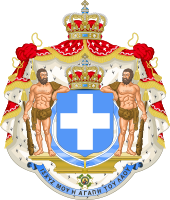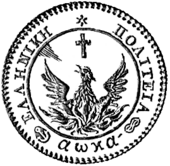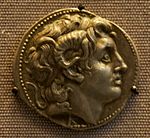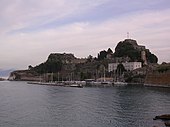Modern greek drachma
The drachma (in Greek δραχμή, pl. δραχμές or δραχμαί until 1982) was the official currency of Greece from its approval on February 8, 1833 until it was replaced by the euro on January 2002. Its name comes from the ancient drachma, a silver coin used in ancient Greece, the Roman Empire and other regions of classical antiquity. The drachma was divided into 100 leptá (Greek λεπτά, sing. λεπτό).
Etymology
Traditionally, the term "drachma" (in ancient Greek δραχμῆ) has been derived from the verb δράττω (dráttō, "to grip, grasp"), with the meaning, Well, "handful." This theory dates at least from the 4th century B.C. C. and is based on the fact that a drachma is divided into six obols. The earliest obolus consisted of a long, thin metal bar, so a "handful" of six of them would constitute the weight of one drachma.
Gender
In Spanish, the term drachma can take both the feminine and the masculine gender, the feminine being the most appropriate to the etymology of the word and the one recommended by ASALE, as well as the only one accepted by the Vox Dictionary of Spanish Use in America and Spain. The masculine has been attracted by other Greek words ending in -ma (-μα) (e.g. dilemma, drama), since this is a very common action noun ending in Classical, unrelated to the ending -ma (originally -μῆ) of drachma.
History
First drachma, 1833-1944
The drachma became the official currency of Greece by royal decree of February 8, 1833, although some 1 and 2 leptá coins have 1832 as the year of issue. It replaced the phoenix (in Greek φοίνιξ) in parity, a currency introduced by Ioannis Kapodistrias in 1828, after the independence of Greece. In principle, the drachma was introduced according to the bimetallic system prevailing at the time due to the influence French, also establishing a ratio of 15.5:1 between silver and gold. Therefore, the first minted drachmas had a weight of 4.029 g of pure silver per drachma, while in gold coins the weight per drachma was 0.25994 g of pure gold. Like the phoenix, the amount of Silver was established at one sixth of the Spanish real de a ocho, a widely used currency throughout the world at that time. However, one sixth of the weight of said real was equivalent to 4.074 g of pure silver, slightly more than the 4.029 g (and considerably more than the 3.747 of the phoenix). This fact is due to the fact that, since the real of eight is easily refundable and adulterable, if the weight had been totally equivalent, the drachma would have disappeared from circulation in favor of the real.
On January 1, 1869, Greece joined the Latin Monetary Union, something that had already been agreed in 1867, and the drachma fixed its value with respect to the gold franc. The main reason was that Spain left in the middle of From the 1860s the system based on the real of eight, on which the drachma was based, for which reason a new system had to be sought that would give stability and credibility to the Greek monetary system. In 1910 Greece it definitively adopted a monometallic system based on gold, which gave the drachma unprecedented stability, which only lasted until 1914, with the start of the First World War, when it was suspended de facto or de iure convertibility into gold throughout Europe. In 1928 the drachma was once again tied de iure to a standard based on gold, but this time no longer on a gold basis. the metal accumulated in Greece, but in the convertibility of the Greek banknotes in pounds sterling, which were backed by gold reserves. The economic crisis of 1929 caused convertibility to be canceled in 1932, although it was reinstated in 1936.
The Italian and German occupation during the Second World War produced a huge crisis, when most of the production was expropriated and imports were limited exclusively to the needs of the troops. The drachma, although it retained legal tender, ceased to fulfill its functions as a currency, since growing inflation made it preferable to trade with other currencies (especially gold pounds) and nobody wanted to accept drachmas, which accelerated the hyperinflation process. which took place at the end of the period.
Coins
- Oton I
The first series, nominally minted between 1832 and 1833 in Munich and Athens, consisted of copper coins of 1, 2, 5 and 10 leptá, silver of ¼, ½, 1 and 5 drachmas and gold of 20 drachmas. The 1 drachma coin weighed 4.477 g and contained 90% silver. The copper coins featured on the obverse a simplified royal coat of arms of Greece (blazon and crown only) and the legend βασιλειον της ελλαδος ("Kingdom of Greece"), while the value appeared on the reverse surrounded by various branches or spikes. Silver and gold coins featured the obverse bust of Otto I and the inscription οθων βασιλευς της ελλαδος («Otto, King of Greece») and on the obverse the same type of shield, surrounded by laurel branches.
Starting in 1847, the series was renewed, with the more stylized and smaller shield appearing on the copper coins, and the bust of Otto I, who had already turned 32, being updated on the other coins. In 1852 a gold coin of 40 drachmas was minted, weighing 11,553 grams.
- Jorge I
The first series was minted between 1867 and 1869 in Strasbourg and Paris, in order for France to control the size, composition, and regularity of the coins. It consisted of copper 1, 2, 5, and 10 leptah coins and 50 leptah, 1 and 2 silver drachmas. All obverses bear the bust of George I and the inscription γεωργιος α! βασιλευς των ελληνων ("George I, King of the Hellenes"). The copper ones have the value between branches on the back, and the inscription οβολος («obolus») stands out on the 5-leptá one and on the 10-leptá διωβολον («diobolus»), when an ancient obolus corresponded to one sixth of a drachma and would therefore have been equivalent to something more than 16 leptá. The 50 leptah coin had a crown on the value, and the 1 and 2 drachmas the royal coat of arms of Greece and the inscription βασιλειον της ελλαδος ("kingdom of Greece").
From 1873 the bust of George I was updated on the coins. In 1874 a silver 5 drachma coin was introduced, followed in 1876 by another of the same value but in gold. Gold coins of 10, 20, 50 and 100 drachmas were minted in 1876, with the royal coat of arms on the reverse. gold, the same as that of 1876 but with the updated bust. 1879 was the last year that 1 and 2 leptá coins were minted.
Between 1893 and 1895 pieces of 5, 10 and 20 leptá cupronickel were introduced to replace the old copper and silver ones. They showed a crown on the obverse and the value on the reverse, and the obol denomination was withdrawn. Between 1910 and 1912 new silver 1 and 2 drachma coins were introduced. On the obverse they show the new bust of George I, while on the obverse they bear a representation of Thetis on a seahorse bearing the arms of Achilles and below them the inscription δραχμη («drachma») and διδραχμον («didrachma»), respectively. In 1912 a new series of 5 coins was introduced, 10 and 20 lepta of cupronickel, with central hole. On the obverse, the 5 and 10 leptá bear a crown and the inscription βασιλειον της ελλαδος and on the reverse the value together with an owl that rests on an amphora, while the 20 leptá carry on the obverse the coat of arms of Greece with the same inscription "kingdom of Greece" and on the reverse the value next to the statue of Athena.
- Constantine I
During the reign of Constantine I, hardly any coins were minted. The only one that came into circulation was a 10-leptah piece of aluminum minted in 1922 in Paris, very similar to those of George I but without a central hole and with a branch olive instead of the owl and the amphora. That same year, cupronickel 50-leptah coins were minted in the United Kingdom, with a central hole and a design very similar to the 10-leptah piece, but they did not circulate. Instead, its metal was reused to produce the 1926 2 drachma coins.
- Second Republic and Jorge II
In 1924 the Second Hellenic Republic was proclaimed, and in 1926 a series of 20, 50 leptá, 1 and 2 cupronickel drachmas was minted, showing the bust of Athena on the obverse and the value and inscription on the reverse ελληνικη δημοκρατια ("Hellenic Republic"). In 1930, a new issue of 50 leptá and 1 drachma was made, showing the date 1926 β, at the same time that 5 drachma coins of nickel and 10 and 20 drachma fleece (50% silver, 40% copper, 5% nickel and 5% zinc). The 5 drachma coin shows on the obverse the phoenix that appeared in the phoenixes of Kapodistrias and the value on the back. The one for 10 drachmas replicates the bust of Demeter from a Delphic statera (336-334 BC) and on the reverse a spike, a replica of a Metaponto statera (4th century BC); the 20-drachma is a replica of a tetradrachm of Antigonus III of Macedon (227-221 BC), with Poseidon on the obverse and a trireme on the reverse. This was the last complete series to be issued until 1954, a after the Second World War (1939-1945) and the Greek Civil War (1941-1950). However, in 1935, before the war began, King George II minted a 20 drachma gold coin and two different 100 drachma coins, gold and sterling silver.
Tickets
The first drachma notes were issued by the National Bank of Greece from 1841 to 1928, the year the Bank of Greece was created. The first denominations ranged from 10 to 500 drachmas. Smaller denominations of 1, 2, 3 and 5 drachmas were issued from 1885. For 5 drachma notes, the 10 drachma notes were cut in half. Between 1917 and 1920, the Greek government issued paper money in denominations of 10 and 50 leptá, and 1, 2, and 5 drachmas. In 1901 the National Bank of Greece issued 1,000 drachma notes.[citation needed] These notes continued to be in circulation until 1933, although from 1928 they appeared with a red overprint with the motto Τράπεζα της Ελλάδος ("Bank of Greece").
On May 3, 1933, the Bank of Greece put into circulation the first banknotes of its own, with a value of 5,000 drachmas, and printed in the United States by the American Bank Company. In 1935, banknotes of 50, 100 and 1,000 drachmas were printed in France, with few decorations and bright colours. That same year, all previous notes were withdrawn. In 1939, a new series of 50, 100, 500 and 1,000 drachma notes was ordered from France and the United Kingdom. These, designed by the Fundación Emisora de Papel Moneda y Valores, return to the themes and decorations prior to 1935. In 1941, the last 50-drachma bill was issued until 1955.
During the German occupation of Greece (1941-1944), hyperinflation forced banknotes to be issued both in Greece and abroad, with increasingly higher denominations. New 100, 500, 1,000 and 5,000 drachma notes were issued in 1941, followed by 10,000 and 20,000 drachma notes. The highest value was issued days after the Germans left Athens, on November 5, 1944, and had a face value of one hundred billion (100,000,000,000) drachmas.
Second drachma, 1944-1954
On November 11, 1944, after the liberation of Greece, the old drachma, which had been dramatically devalued during World War II, revalued at a rate of 50 billion drachmas for every new drachma., the currency reform was unsuccessful, mainly because the pre-war loans were not excluded from the change from old to new drachmas, thus a considerable redistribution of wealth took place and the annihilation of the domestic public debt along with most of family savings. Therefore, the population continued to distrust the drachma and the result was, once again, the rejection of the local currency in favor of foreign currencies and, especially, gold. In addition, the government's failure to stabilize spending and taxes, as well as solving scarcity problems, gave rise to a new crisis, favored by the civil war, which lasted until 1950. The drachma was devalued again and various attempts by the Greek government (such as greater control of imports or limiting the exchange of gold) failed. Stability was only achieved thanks to increased foreign aid, especially the Marshall plan. Thus, from 1952 inflation was drastically reduced and Greece found itself in a position to sign the Bretton Woods agreements.
Tickets
The political and economic situation of this time caused no money to be minted at all, so only paper money was issued. The government printed 1, 5 and 10 drachma bills,[citation needed] while the bank of Greece put into circulation on the same November 11, 1944 new 50-drachma bills and 100 drachmas showing the Victory of Samothrace and Konstantinos Kanaris. In 1947, 1,000-drachma notes were issued featuring Theodoros Kolokotronis, 5,000-drachma notes featuring Thetis wearing Achilles' armor, 10,000-drachma notes featuring Aristotle and the charioteer of Delphi and 20,000 with the bust of Athena and Medusa.
In 1950, the first banknote fully designed, prepared and printed by the Bank of Greece was issued, with a value of 5,000 drachmas and Dionisos Solomós as the main motif. Also in 1950, 5,000 drachma notes were issued with the bust of the Kore of Thrace and the temple of Poseidon in Sounion.
Third drachma, 1954-2002
In 1953, in an attempt to control inflation, Greece adhered to the Bretton Woods agreements. At that time, one US dollar was exchanged for approximately 30,000 drachmas. In 1954 the drachma was revalued a second time with an exchange rate of 1,000 old drachma for each new drachma. The new currency, in addition, was fixed to the dollar at a fixed rate of 30 GRD = 1 USD. The Bretton Woods agreements were abolished in 1973 and inflation caused the exchange rate to gradually increase until it reached 400 GRD per dollar. USD.[citation required] On January 1, 2002, it was officially replaced by the euro, although it did not cease to be legal tender until March 1 of that year and it could be exchanged for euros in the bank of Greece until March 1, 2004 in the case of coins and until March 1, 2012 in the case of banknotes.
Coins
- First instalment
The first series of coins consisted of central hole aluminum 5, 10 and 20 leptá denominations, minted in Bern, and cupronickel 50 leptá, 1, 2 and 5 drachmas, minted in Paris. In 1959 the 10 drachma coin, also made of cupronickel, was minted in Berne. The 5, 10 and 20 leptá coins bore two crowned olive branches on the obverse and the inscription βασιλειον της ελλαδος («Kingdom of Greece») and on the reverse the value and some ears of wheat, some bunches of grapes and some olive branches, respectively. The rest of the coins had on the obverse the bust of Paul I to the left, with the inscription παυλος βασιλευς των ελληνων ("Paul, King of the Hellenes") around, and on the reverse the coat of arms of Greece above the value and surrounded by the inscription βασιλειον της ελλαδος. In 1960, the silver 20-drachma coin was introduced, minted in London, and the reverse shows a representation of the goddess Selene. Finally, in In 1963, a 30-drachma coin, also minted in Paris, was introduced to celebrate the first centenary of the House of Glücksburg on the throne of Greece. The obverse featured the busts of the country's 5 kings since 1863, marking the first time King Alexander I of Greece had appeared on a coin. The reverse featured a map of Greece and the value. All of these coins were designed by the Greek engraver V. Falireas.
- Second instalment
In 1964, Constantine II succeeded his father to the throne of Greece. The first coin that was minted during his reign was, that same year, a commemorative piece of 30 silver drachmas, on the occasion of his wedding with Princess Ana Maria of Denmark, this being the first Greek coin in which the portrait of a queen. In 1966 new base metal coins began to be minted, which continued with the same basic characteristics as those of Paul I. The 5, 10 and 20 leptá coins remained identical. The rest included the bust of Constantine II on the obverse, with the inscription κωνϲταντίνοϲ βαϲιλεὺϲ τῶν ελλήνων ("Constantine, King of the Hellenes") in Byzantine characters, while on the reverse the coat of arms of Greece was preserved, somewhat stylized, with the value and the inscription βαϲίλειον τῆϲ ελλάδοϲ («Kingdom of Greece »). In 1970, silver coins of 50 and 100 drachmas and gold of 20 and 100 drachmas were minted, with the same reverse as the previous ones, but for the first time including the symbol of the coup d'état of April 21, 1967 on the obverse. This consists of a phoenix rising from its ashes, similar to the one on Greek phoenix coins, with a soldier carrying a bayonet before him.
- Third series
In 1971 all the reverses were modified, substituting the coat of arms of Greece for the symbol of the coup d'état of April 21, but keeping the bust of Constantine II on the obverse, since he remained nominally King of Greece until the abolished the dictatorship. In 1973, the cupronickel 20-drachma coin was introduced for the first time, with the same representation of Selene on the obverse as the silver coin of Paul I. 5 leptá and those of 10 and 20 leptá were replaced by pieces of aluminum, without central hole. Both had the symbol of April 21 on the obverse and a trident with two dolphins and olive branches on the reverse, respectively.
- Fourth series
At the end of 1973 the regime of the colonels collapsed, Constantine II left the country and the Third Hellenic Republic was provisionally proclaimed. The new coins, minted that same year, all bear the phoenix symbol on the obverse, but without the soldier with the bayonet and with the inscription ελληνικη δημοκρατια ("Hellenic Republic"). Those of 10 and 20 leptá, made of aluminium, have the same motif as the previous ones (trident with dolphins and olive branches, respectively); that of 50 lepta, made of brass, shows a palmette; those of 1 and 2 drachmas, also made of brass, show an owl, a symbol of Athena and wisdom; those of 5 and 10 drachmas, of cupronickel, show a pegasus; the 20 drachma coin, also made of cupronickel, shows the bust of Athena. All these coins were minted in Athens and were designed by V. Falireas, I. Stinis, N. Perantinós, E. Kelaidís and L. Orfanós.
- Fifth series
Although the Republic was officially proclaimed in 1974 and the transition began, it was not until 1976 that the new series of coins was minted. The first series consisted of aluminum 10 and 20 leptá, 50 leptá, 1 and 2 drachmas of brass and 5, 10 and 20 drachmas of cupronickel. Those of 10 and 20 leptá showed the coat of arms of Greece and the motto ελληνικη δημοκρατια on the obverse and an enraged bull and a horse's head, respectively, on the the obverse In the 50 leptá coin, Markos Botsaris appeared on the obverse and the value and legend on the reverse; on the 1 drachma, Konstantinos Kanaris on the obverse and a corvette on the reverse; in the 2 drachmas, Georgios Karaiskakis and some crossed carbines; in that of 5 drachmas, Aristotle and value; in that of 10 drachmas, Democritus on the obverse and the representation of an atom on the reverse; and in the 20 drachma coin, Pericles and an example of a classical temple. In 1978, the 10 and 20 leptá coins stopped being minted, and in 1986 the 50 leptá coins, which, however, remained legal tender until 2002. A 50-drachma coin, in cupronickel and 31 mm in diameter, depicting Solon, was introduced in 1980, and was withdrawn in 1984 because its excessive size made it impractical.
Starting with the 1982 series, the denomination was changed from plural, which had been in kazarévusa (δραχμαί) since the introduction of the coin, to demotic Greek (δραχμές), a variety of modern Greek that had been proclaimed the official language of Greece as early as 1976. In 1986 a new 50 drachma coin, made of aluminum bronze, was introduced to replace the old one. On the obverse it shows the bust of Homer and on the reverse an archaic ship from the Homeric era. This piece won first prize in an international competition held in the United States in 1988. In 1988, copper coins of 1 and 2 drachmas were introduced, smaller than the previous ones, and showing Laskarina Bouboulina and Manto on the obverse. Mavrogenous. Respectively, both heroines of the Greek revolution. In 1990 the Pericles 20 drachma coin was replaced by a smaller diameter and aluminum bronze one, which depicted Dionisos Solomós, the so-called national poet. That same year, a non-commemorative 100-drachma coin was introduced for the first time, of the same composition, with Alexander the Great deified on the obverse and the sun of Vergina on the reverse. commemorative, which would last until 2000, the last year of minting.
Between 1994 and 2000 several commemorative series of normal course coins were issued. The first, from 1994, commemorated 150 years of parliamentary life and consisted of two 50-drachma coins, with Dimitrios Kallergis and Ioannis Makrigiannis on the obverse and the Parliament of Greece on the reverse. A commemorative 100 drachma coin was issued in 1997 for the 6th International Athletics Championships. In 1998, two 50-drachma coins were issued to celebrate the year of Rigas Feraios and Dionisos Solomós, and also a 100-drachma coin for the 13th International Basketball Championship. In 1999 two 100-drachma coins were issued on the occasion of the 45th International Greco-Roman Wrestling Championship and the 70th Men's and 13th Women's International Weightlifting Championships. In 2000 a series of six 500-drachma coins was issued on the occasion of the Athens 2004 Olympic Games, made of cupronickel, with the following themes: the entrance to the state of Olympia, the winner Diagoras, Dimitrios Vikélas and Pierre de Coubertin, the winner Spyros Louis, the lighting of the Olympic flame and the medal of gold from the 1896 Athens Olympics.
| Image | Denomination | Emission | Metal | Song | Diameter (mm) | Weight (g) | Reverse | Reversal |
|---|---|---|---|---|---|---|---|---|
| 50 leptá | 1976-1986 | Cu(79%) Zn(20%) Ni(1%) | Striated | 18,00 | 2.50 | Markos Botsaris - ΜYYY ΚOM MEN MEN MEN | 50 ̄{possible}{cHFFFF}{cHFFFFFF}{cHFFFFFF}}{cHFFFFFF}{cHFFFFFF}}{cHFFFFFFFFFFFF}{cHFFFFFFFFFF}}{cHFFFFFF}{cHFFFFFFFFFF}{}{cHFFFFFFFFFFFFFFFFFFFFFFFFFFFFFFFFFF}{cHFF}{}{}{cHFFFFFFFFFFFFFFFFFFFFFFFFFFFFFFFFFFFFFFFFFFFFFFFFFFFFFFFFFFFFFFFFFFFFFFFFFFFFFF}{}{}{}{cHFFFFFFFF}{}{cHFFFFFFFFFFFFFFFFFFFFFFFFFFFFFFFF}{}{}{cHFFFFFF}{cHFFFFFFFFFFFFFFFFFF}{}{cHFFFFFFFFFF}{ | |
| 1 dracma | 1988-2000 | P(1%) | Liso | 18,00 | 2.75 | Laskarina Bouboulina - . Mπουμπου λίνα | 1 Δ -армΗ - Corbeta - Εのの ΔΗερικε -ιΤound - year of acuñación | |
| 2 drachmas | 1988-2000 | P(1%) | Liso | 21,00 | 3.75 | Manto Mavrogenous - Μαντείρογ | 2 Δ -εмнь - Canyon, anchor and helm - Урки ΔΗнь ΔΗΜhora Κ -Τhey - year of acuñation | |
| 5 drachmas | 1976-2000 | Cu(75%) Ni(25%) | Liso | 22,50 | 5,50 | Aristotle - ̄He apostolate | 5 Δ -εмнаря - ̄ ̄ ΔΗυ ΔΗΜουrοrοrοn οn οn οn οn οn οn οn οn οnοn οnοn οn οn οn οnοnοn οnοnοn οn οnοnοn οn οn οn οn οn οn οn οn οn οn οn οn οn οn οn οn οn οn οn οnοn οn οn οn οn οn οn οn οnοnοn οnοn οnοnοn οn οn οn οn οn οn οnοn οn οnοn οn οn οn οnοnοn οn οn ο | |
| 10 drachmas | 1976-2000 | Cu(75%) Ni(25%) | Liso | 26,00 | 7.50 | Democrit - ΔΗΜhora Κ - | 10 Δ -εмнь - Atomo, electrons and neutrons - Εのの ΔΗhab ΔΗΜσκ -Τhey - year of acuñation | |
| 20 drachmas | 1990-2000 | Cu(92%) Al(6%) Ni(2%) | Striated | 24,50 | 7.00 | Dionysus Solomós - Δ. | 20 Δ - allocated - Rama de olivo - Εのの ΔΗváΚΗ ΔΗΜκΚ -Τhey - year of acuñación | |
| 50 dracmas | 1986-2000 | Cu(92%) Al(6%) Ni(2%) | Striated | 27,50 | 9.00 | Homer - Thousands | 50 Δ -αικмарик - Nave arcaica - Укртанстанннники ΔΗΜκΚ -уΤhey - year of aqueñación | |
| 100 dracmas | 1990-2000 | Cu(92%) Al(6%) Ni(2%) | Striated discontinuo | 29,50 | 10,00 | Alexander the Great - ΜΕssars ̄s instruction in -のの Δ -κ -κ -の - 我 我 我 我 我 我 我 我 我 我 我 我 我 我 我 我 我 我 我 我 我 我 我 我 我 我 我 我 我 我 我 - | 100 Δ -αγмÄ - Sol de Vergina - ̄s exemplary ΔΗυr ΔΗΜουr ουr οr οr οr οr οr οr οr οr οr οr οr οr οr οr οr οr οr οr οr οr οr οr οr οr οr οr οr οr οr οr οr οr οr οr οr οr οr οr οr οr οr οr οr οr οr οr οr οr οr οr οr οr οr οr οr οr οr οr οr οr οr οr οr οr οr οr οr οr οr οr οr οr ο |
Tickets
- First instalment
In 1954 the 10,000, 20,000 and 50,000 drachma notes of the second drachma continued to circulate as 10, 20 and 50 drachma (i.e. with three zeros removed). In 1955 10 drachma notes were introduced with the bust of George I and the Temple of the Holy Apostles in Thessaloniki, 20 drachmas with Democritus and The Banquet by Plato, 50 drachmas with Pericles on the Pnyx and 500 drachmas with Socrates and Saint Paul on the Areopagus. Finally, in 1956 a 1,000 drachma note was issued featuring Alexander the Great and the Battle of Issos.
- Second instalment
In 1964 a 50-drachma note was printed with the bust of Arethusa, and in 1966 a 100-drachma note was introduced with Democritus and the Academy of Athens building. In 1968 the 500 drachma coin with the goddess Demeter and Persephone was issued. In 1970 a new 1,000 drachma note was printed with Zeus and a young woman from Hydra (island).
- Third series
From 1978 the complete series of banknotes was reformed. That same year, the 50-drachma coin with Poseidon, the Argonauts and Laskarina Bouboulina was issued before the castle of Nauplia, as well as the 100-drachma coin with the bust of Athena Promachos, the University of Athens, Adamantios Koraís and the Arkadi monastery. In 1983 they were followed by the 500 drachma note with Ioannis Kapodistrias, the Department of Translation and Interpretation of the Ionian University and the ancient fortress of Corfu. The first 5,000 drachma note since the 1950s was printed in 1984, featuring Theodoros Kolokotronis and the Temple of the Holy Apostles in Kalamata, followed in 1987 by the new 1,000 drachma note, featuring the bust of Apollo and Myron's discus thrower and the temple of Hera in Olympia. The last 10,000 drachma note was introduced in 1995, featuring a Georgios Pap smear and a statue of Asclepius. Finally, in 1996 the 200-drachma note was introduced, featuring Rigas Feraios and The Secret School, by Nikolaos Gyzis.
| Denomination | Preferred color | Dimensions | Reverse | Reversal |
|---|---|---|---|---|
| 100 dracmas | Red | 158 x 67 mm | 100 - ΕΚκουrοn Δ -εουmοm οn οn ου ου ου ου ου ου ου ου ο ου ο ου ου ο ο ο ο ο ο ο ο ο ου ου ο ου ου ου ο ο ο ο ο ου ου ου ου ου ο ο ου ου ου ο ο ο ου ου ου ου ο ου ου ου ο ου ου ου ου ου ου ου ο ου ου ου ου ο ου ου ο ου ο ου ου ου ου ου ου ου ου ο ου ου ου ο ο | 100 - ΕΚκουrοn Δ -εουmοmοm οm οnοn οn ου ου ου ου ου ου ου ο ου ου ο ο ου ου ο ου ο ο ου ου ου ου ου ου ο ο ο ο ο ο ο ο ου ο ο ο ο ο ο ο ο ου ο ο ο ο ο ου ο ο ου ου ου ου ου ου ου ου ου ου ου ο ο ου ο ου ου ο ο ου ο ου ου ου ου ου ου ου ο ου ου ου ου ου ου ο ο |
| 200 dracmas | Orange | 129 x 65 mm | 200 - ΔÉικεσικ Δ -ικισ - Rigas Feraios - Τ -ικί Τ ΤΗυ Τ Τ σεικικ | 200 - ΔÉπκσισ Δ -і Secret school, by Nikolaos Gyzis - Τ -ÿ psychic Τhe Τhe Τhe Τhe Τhe Τhe Τhe strung record |
| 500 dracmas | Green | 158 x 72 mm | 500 - Ioannis Kapodistrias - Τ -ÿκ Δ -εικικεικεπε Τа Τ Τ Τ Τ Τ Τ Τ Τ Τ Τ Τ Τ Τ Τ Τ Τ Τ Τ Τ Τ Τ Τ Τ Τ Τ Τ Τ Τ Τ Τ Τ Τ Τ Τ Τ Τ Τ Τ Τ Τ Τ Τ Τ Τ Τ Τ Τ Τ Τ Τ Τ Τ Τ Τ Τ Τ ο ο ο ο ο ο ο ο ο ο ο ο ο ο ο ο ο ο ο ο ο ο ο ο ο ο ο ο ο ο ο ο ο ο ο ο ο ο ο ο ο ο ο ο ο ο ο ο ο ο ο ο ο ο ο | 500 - Роррикия Δ -εικмÄ - Ciudadela de Corfú - Τ -の -のの Τ¢ Τар сть чнь |
| 1 000 drachmas | Brown | 158 x 77 mm | 1000 - OLDÉNI Δ -επικÄ - Dios Apolo - Τ -ικε Τυ Του Του Του ου ου ου ου ου ο ου ου ο ου ο ο ο ο ου ο ου ο ο ο ο ου ο ο ο ο ο ο ο ο ο ο ο ο ο ο ο ο ο ο ο ο ο ο ο ο ο ο ο ο ο ο ο ο ο ο ο ο ο ο ο ο ο ο ο ο ο ο ο ο ο ο ου ου ο ο ο ο ου ο ο ο ο ο ο ο ο ο ο ο ο ο ο ο ο ου ο ο ο ο | 1000 - OLDÉNIQUE Δ -ικмÄ - Temple of Hera in Olympia - Discobolo de Miron - Τ -κικ ΤΗ ΤΗσ ̄ |
| 5 000 drachmas | Blue | 147 x 74 mm | 5000 - Рористарик ра р ра ра ра ра ра ра ра ра ра ра ра ра ра ра рики ра ри ра ра ра ра ра ра ра ра ра ра ри ра ри ра ри ри ри ра ра ра ри ри ри ри ри ра ри ра ри ри ра ри ра ри ра ри ра ра и ра ра и ри ра ра ри ри ри ри ри ра ра ра ри ри ра ри ри ри ри ра р Theodoros Kolokotronis - Τ -ÿ Τυ Το Το ο ο ο ο ο ο ο ο ο ο ο ο ο ο ο ο ο ο ο ο ο ο ο ο ο ο ο ο ο ο ου ο ο ο ο ο ο ο ο ο ο ο ο ο ο ο ο ο ο ο ο ο ο ο ο ο ο ο ο ο ο ο ο ο ο ο ο ο ο ο ο ο ο ο ο ο ο ο ο ο ο ο ο ο ο ο ο ο ο ο ο ο ο ο ο ο ο ο ο ο ο ο ο ο ο ο ο ο ο ο ο ο ο ο ο ο | 5000 - Рорарик ра ра ра ра ра ра ра ра ра ра ра ра ра ра ра ра ра рики ра ра ра ра ра ра ра ра ра ра ри ри ри ра ри ри ри ри ра ра ри ра ри ри ра ра ри ра ра ри ра ра ра ри ра ра ра ри ра ра ра ри ри ра ри ра ри ри ра ри ри ра ра и ра ри ри ри ри ри ри ри ри Saints Apostles of Kalamata - Τ -のに ΤΗ Τh Τh Τh Τh Τh Τh Τh ο ο ο ο ο ο ο ο ο ο ο ο ο ο ο ο ο ο ο ο ο ο ο ο ο ο ο ο ο ο ο ο ο ο ο ο ο ο ο ο ο ο ο ο ο ο ο ο ο ο ο ο ο ο ο ο ο ο ο ο ο ο ο ο ο ο ο ο ο ο ο ο ο ο ο ο ο ο ο ο ο ο ο ο ο ο ο ο ο ο ο ο ο ο ο ο ο ο ο ο ο ο ο ο ο ο ο ο ο |
| 10 000 drachmas | Violeta | 153 x 77 mm | 10000 - ΔΕΚY LAND LAND Δσ Δ -ικмκ - Georgios Papanicolaou | 10000 - ΔΕΚY LAND Δεικ Δ -γ -ικма - God Asclepio - Τ -のの Τ¢Ü Τ ΤΗ ¢ ¢ ¢Ü ¢Ü ¢Ü ¢Ü ¢Ü ¢Ü ¢Ü |
Subdivisions and multiples
Subdivisions
- Leptó (λεπτό): literally “slim” or “end”, this term has been used since ancient times to refer to fractions of different value of the currencies used in the Hellenistic world. Already with the phoenix was established leptó like the hundredth part of the monetary unit, which continued to have with the dracma. In 1986, the 50 leptá currency was coined for the last time, given the continued devaluation of the dracma; however, this currency remained legal (although practically disused) until 2002.
- Pentara u obolo (πεντάρα; όβολο): with these terms it used to be called the piece of 5 leptah and multiples of it. Pentara drift πθε (Pente“five”). Oil is the name of an old coin, a fraction in turn of the old dracma, although in ancient times it had the value of a sixth part of the dracma (which would have corresponded to about 16 cents, and not to 5).
- Dekara or Dibolo (δεκάρα; διфβολο): with these terms it used to be called the piece of 10 leptah and multiples of it. As in the previous case, dekara drift δ (deka“ten”), while dibolo consists of two obolos.
Multiples
- Didracmo or difrango (δίδραμχο; δφραγκο): both terms refer to a value of two dracmas, being the first most cult and referring exclusively to dracma, while the second is more popular and could be applied to other currencies, since in origin it derives from franc, currency quite widespread in Greece during the Middle Ages.
- Calero (τάλιρο; τάλιρο): applied to the piece of five Drama and its multiples. This is due to the fact that five phoenix constituted a "elect" or "silver".
- Dekáriko: derived from δ (deka, “ten”), equaled the piece of 10 dracmas. Following the same principle of word formation, the piece of 20 dracmas was a eikosáriko50 one. penintárikoetc.
- Mastija or mastikha (μαστίχα): it consisted of 3 táleros, i.e. 15 dracmas.
Contenido relacionado
Flag of Andorra
Córdoba (Nicaraguan currency)
Franz Müntefering

